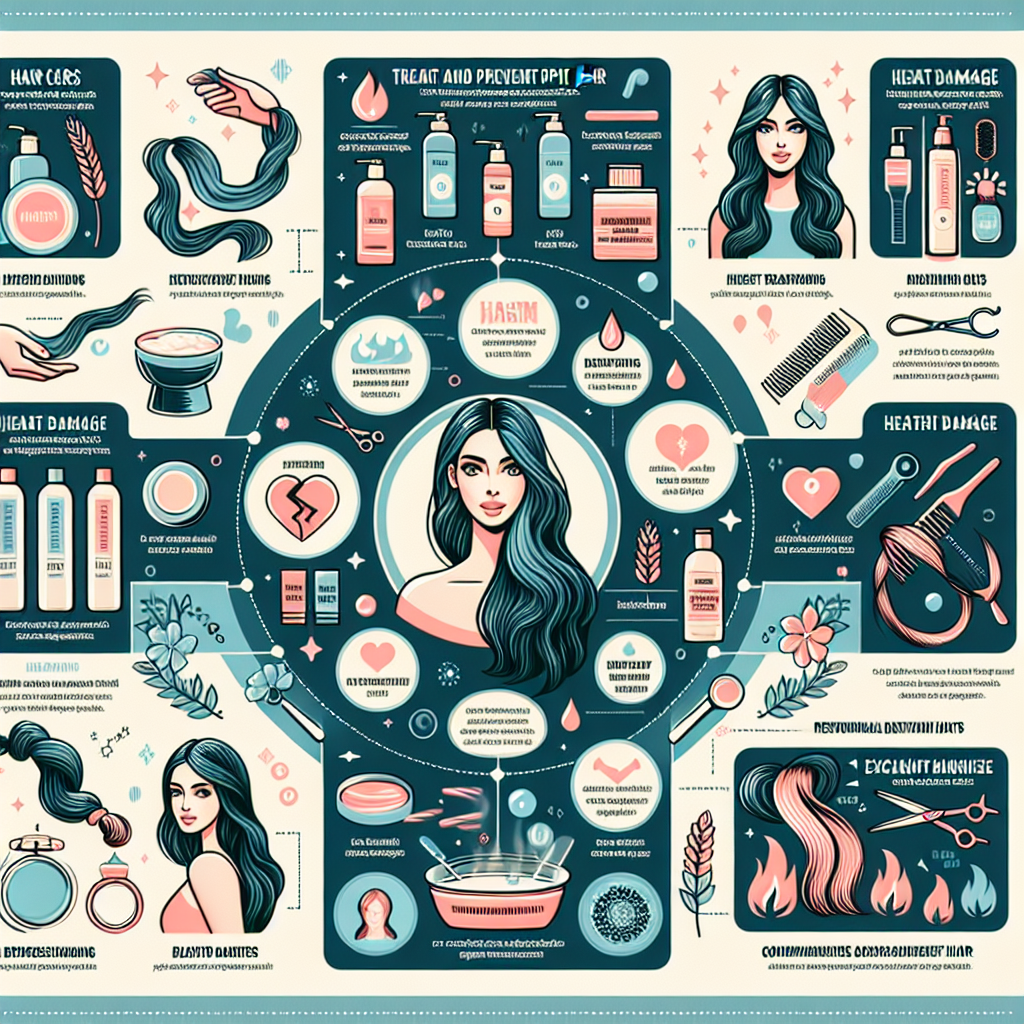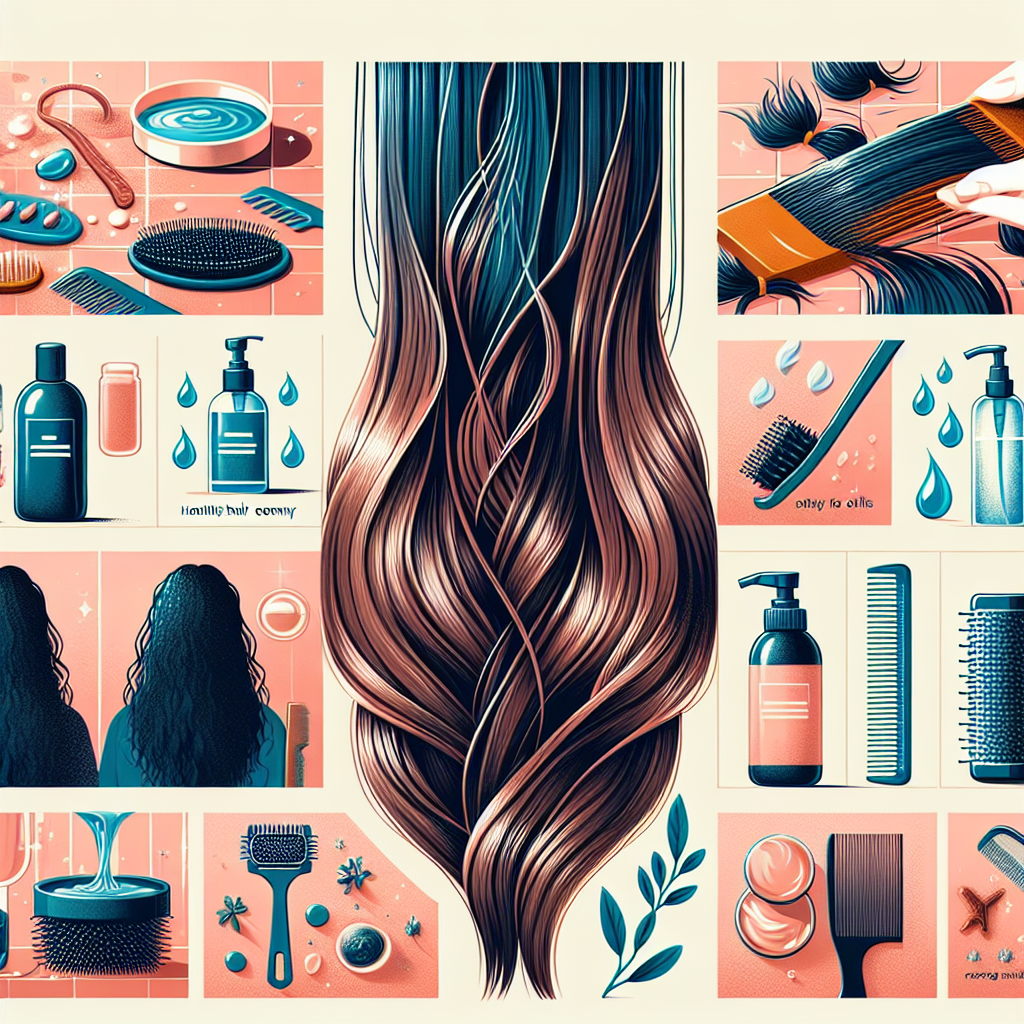If you’ve ever found yourself staring at your reflection and wondering how to banish those pesky split ends that seem to appear out of nowhere, you’re not alone. Dealing with split ends can be a frustrating and time-consuming endeavor, but fear not! In this article, we’ll explore some simple and effective tips on how you can treat and prevent split ends in your hair, leaving you with locks that are healthy, shiny, and split end-free. So bid farewell to those pesky split ends and say hello to luscious, vibrant hair!
Causes of Split Ends
Split ends, also known as trichoptilosis, occur when the protective outer layer of the hair cuticle becomes damaged, leading to the splitting of the hair shaft. There are several factors that can contribute to the formation of split ends:
Heat styling
Using heat styling tools such as flat irons, curling irons, and blow dryers can cause damage to the hair, leading to split ends. The high temperatures from these tools can strip the hair of its natural moisture, making it more prone to breakage and splitting.
Chemical treatments
Chemical treatments such as hair coloring, perming, and relaxing can weaken the hair shaft and cause it to become brittle. This can eventually lead to the formation of split ends. It is important to ensure that these treatments are done by professionals and follow proper aftercare routines to minimize damage.
Over-washing
Washing your hair too frequently can strip it of its natural oils, leaving it dry and more prone to splitting. It is recommended to wash your hair every other day or every few days to maintain its natural moisture balance.
Improper brushing
Brushing your hair vigorously or using a brush with harsh bristles can cause friction and damage to the hair cuticle, leading to split ends. It is best to use a wide-toothed comb or a brush with soft bristles to gently detangle your hair.
Environmental factors
Exposure to environmental factors such as harsh sunlight, pollution, and extreme weather conditions can also contribute to the formation of split ends. These external stressors can weaken the hair, making it more susceptible to damage.
Signs and Symptoms of Split Ends
Spotting split ends early is essential in preventing further damage. Here are some signs and symptoms to look out for:
Frayed hair strands
If you notice that the ends of your hair have become frayed and look thin, it could be a sign of split ends. The hair shaft may appear rough and uneven, indicating damage to the cuticle layer.
Visible split ends
Split ends can be easily identified by the presence of a visible split or separation in the hair strand. You may notice that the hair splits into two or more separate strands, giving it a frayed and unhealthy appearance.
Difficulty styling
Split ends can make it challenging to style your hair as they tend to be more prone to tangling and breakage. Hairstyles may not hold as well, and you may struggle to achieve a smooth and polished look.
Dry and brittle hair
If your hair feels dry, rough, and lacks shine, it could be a sign of split ends. Split ends can cause the hair to become weak and brittle, making it more susceptible to breakage.

The Importance of Treating Split Ends
Treating split ends is crucial for the overall health and appearance of your hair. Ignoring split ends can lead to further damage and prevent your hair from reaching its optimal state. Here’s why it’s essential to address split ends:
Preventing further damage
If left untreated, split ends can travel up the hair shaft, causing more breakage and damage. By regularly trimming your hair and treating split ends, you can prevent them from spreading and causing more harm.
Maintaining hair health and appearance
Removing split ends helps to improve the overall health and appearance of your hair. By getting rid of damaged ends, your hair will look healthier and feel smoother. It also reduces the risk of tangling and makes styling easier.
Helping hair growth
Split ends can hinder the growth of your hair. By treating and preventing split ends, you create a healthier environment for your hair to grow. Regular trims and proper haircare practices can promote hair growth and prevent breakage.
Trimming and Cutting Techniques
To effectively address split ends, it is necessary to trim or cut your hair. Here are some techniques that can be used:
Regular haircuts
Scheduling regular haircuts is essential to maintain the health of your hair and prevent the formation of split ends. Trimming your hair every 6-8 weeks can help remove any existing split ends and promote healthy hair growth.
Split end trimming
Split end trimming is a technique where only the damaged ends of the hair are removed, leaving the healthy hair intact. This can be done using specialized scissors designed to remove split ends without affecting the length of your hair.
Professional hairdressing tools
Professional hairdressers use specialized tools, such as hairdressing shears, to ensure precision and minimize damage during trimming. These tools are specifically designed to cut the hair without causing further splitting or breakage.

Haircare Practices to Prevent Split Ends
Preventing split ends is just as important as treating them. By following these haircare practices, you can minimize the risk of developing split ends:
Using a wide-toothed comb
When detangling your hair, opt for a wide-toothed comb to avoid causing friction and breakage. Start from the ends and work your way up, gently removing tangles without pulling or tugging on the hair.
Avoiding excessive heat
Limit the use of heat styling tools as much as possible. When using them, apply a heat protectant spray to minimize damage. Opt for air-drying whenever you can and avoid using high heat settings on your blow dryer.
Choosing gentle hair accessories
Avoid using hair accessories with metal parts that can snag and cause breakage. Opt for accessories made from soft materials such as fabric or coated plastic to reduce friction and damage to the hair.
Minimizing chemical treatments
If possible, reduce the frequency of chemical treatments such as hair coloring or perming. When getting these treatments, ensure they are done by professionals who can minimize damage and recommend appropriate aftercare routines.
Not over-washing
Washing your hair too frequently can strip it of its natural oils, leading to dryness and the formation of split ends. Instead, opt for a gentle shampoo and consider washing your hair every other day or every few days to maintain its natural moisture balance.
Using a microfiber towel
Replace your regular towel with a microfiber towel when drying your hair. Microfiber towels are gentler on the hair and help to minimize friction and breakage. Pat dry your hair instead of rubbing to reduce damage.
Natural Remedies for Split Ends
In addition to regular trims and proper haircare practices, natural remedies can be used to nourish and repair split ends. Here are some remedies you can try:
Coconut oil
Coconut oil is known for its moisturizing properties and can help repair split ends. Apply a small amount of coconut oil to the ends of your hair, leave it on for a few hours or overnight, and then wash it out. The oil will hydrate the hair and reduce the appearance of split ends.
Avocado mask
Avocado is rich in vitamins and fatty acids that can nourish and repair split ends. Mash up a ripe avocado and apply it to the ends of your hair. Leave it on for 30 minutes to an hour, then rinse it out. This mask will provide deep hydration and help to reduce split ends.
Egg mask
Eggs are packed with protein, which can strengthen the hair and reduce breakage. Whisk an egg and apply it to the ends of your hair. Leave it on for 20-30 minutes, then rinse it out with cold water. This mask will help to repair split ends and improve the overall health of your hair.
Honey treatment
Honey is a natural humectant that can help lock in moisture and prevent split ends. Mix equal parts honey and water, apply it to the ends of your hair, and leave it on for 30 minutes to an hour. Rinse it out thoroughly and enjoy the moisturizing benefits of this treatment.
Banana mask
Bananas are rich in vitamins and minerals that can nourish and strengthen the hair. Mash up a ripe banana and apply it to the ends of your hair. Leave it on for 30 minutes, then rinse it out. This mask will help to repair split ends and leave your hair feeling soft and smooth.

Specialized Haircare Products
In addition to natural remedies, there are specialized haircare products that can help prevent and treat split ends. Here are some options to consider:
Split end serums
Split end serums are formulated to target and repair split ends. These serums coat the hair strands, sealing in moisture and reducing the appearance of split ends. Look for serums that contain nourishing ingredients such as argan oil or keratin.
Leave-in conditioners
Leave-in conditioners provide an extra layer of moisture and protection to the hair. They can help to detangle the hair, reduce friction, and prevent breakage. Apply a small amount of leave-in conditioner to the ends of your hair after washing and leave it in without rinsing.
Protein treatments
Protein treatments help to strengthen the hair and reduce breakage. These treatments replenish the protein lost in the hair, improving its elasticity and resilience. Look for protein-based treatments and follow the instructions for optimal results.
Silicone-based products
Silicone-based products can help to smooth and seal the hair cuticle, reducing the appearance of split ends. These products create a barrier on the hair shaft, protecting it from environmental stressors and minimizing damage. Use silicone-based serums or leave-in conditioners sparingly to avoid buildup.
Diet and Nutrition
A healthy diet plays a significant role in the health of your hair. Here are some dietary tips to prevent split ends:
Consuming a balanced diet
Eating a balanced diet that includes a variety of fruits, vegetables, lean proteins, and whole grains provides the necessary nutrients for healthy hair growth. Include foods rich in vitamins A, C, and E, as well as biotin and omega-3 fatty acids.
Increasing protein intake
Protein is the building block of hair, so ensuring an adequate intake is crucial. Include lean meats, poultry, fish, eggs, legumes, and dairy products in your diet to meet your protein requirements.
Taking supplements
Supplements such as biotin, collagen, and omega-3 fatty acids can support hair health and prevent split ends. Consult with a healthcare professional before starting any supplements to ensure they are suitable for you.
Staying hydrated
Drinking plenty of water is essential for maintaining the overall health and hydration of your hair. Dehydration can lead to dryness, making the hair more prone to splitting. Aim to drink at least 8 glasses of water per day.

Protective Hairstyles
Protective hairstyles can help to minimize friction and reduce the risk of breakage and split ends. Here are some protective styles to consider:
Braids
Braiding your hair can help to keep it contained and protected from external stressors. Opt for loose and gentle braids that do not pull tightly on the hair. Avoid using rubber bands or metal accessories that can cause breakage.
Buns
Wearing your hair in a bun helps to keep the ends tucked away and protected. Use soft hair ties or scrunchies that won’t cause breakage. Avoid pulling the hair tightly to prevent tension and breakage.
Ponytails
When wearing a ponytail, opt for a loose and low ponytail to minimize tension on the hair. Use soft hair ties or scrunchies and avoid pulling the hair too tightly. Alternate the position of your ponytail to prevent excessive stress on specific areas.
Professional Hair Treatments
In addition to at-home care, professional hair treatments can provide intensive nourishment and repair to your hair. Here are some treatments to consider:
Keratin treatment
A keratin treatment helps to smooth and strengthen the hair by infusing it with keratin, a protein that is naturally present in the hair. This treatment can reduce frizz, improve manageability, and minimize the appearance of split ends.
Hair spa
A hair spa treatment is a luxurious and indulgent way to pamper your hair. It involves deep conditioning, massage, and nourishing treatments that can revitalize and repair damaged hair. A hair spa treatment can help to restore moisture and reduce split ends.
Hot oil massage
A hot oil massage involves applying warm oil to the scalp and hair, massaging it in, and leaving it on for a period of time to nourish and strengthen the hair. This treatment can improve blood circulation, promote hair growth, and provide deep hydration to prevent split ends.
Taking care of your hair and preventing split ends requires a combination of proper haircare practices, regular trims, and nourishing treatments. By following these tips and incorporating them into your haircare routine, you can maintain healthy, split-end-free hair that looks and feels great. Remember, prevention is key, so invest time and effort in caring for your hair to prevent damage and maintain its natural beauty.






